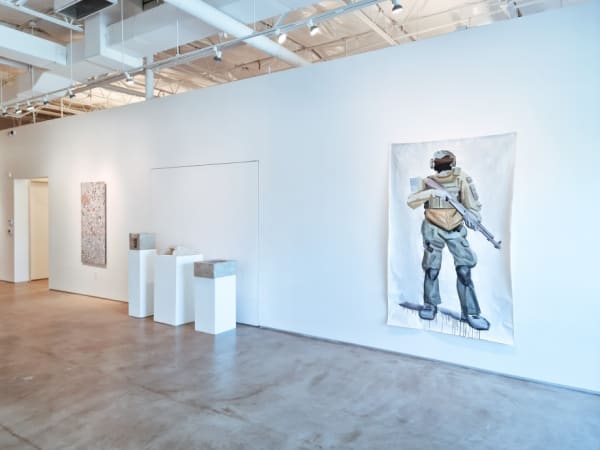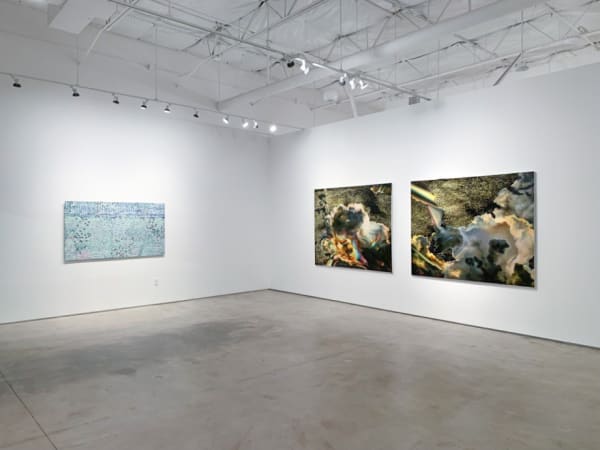Artists Know Better
Voloshyn Gallery, together with Dallas Art Fair Projects, presents ARTISTS KNOW BETTER, an exhibition of contemporary Ukrainian artists reflecting on the radical situation of russia’s full-scale war against Ukraine. Working on the edge of different techniques and media, while combining research with intuition, artists often foresee events to come. Many of the works showcased in the exhibition were created after 2014 but before the russia’s full-scale invasion in 2022, taking on new meaning in today’s environment. Other works were created amidst the invasion that has shaken the world. In this exhibition, we recognize the significance of an artistic statement in time of war and how artworks garner new weight in the context of history.
In the first part of the exhibition, Lesia Khomenko, Nikita Kadan, Danylo Halkin, Yevgen Samborsky, Vlada Ralko, Daniil Revkovskiy and Andriy Rachynskiy contemplate and directly respond to the war in works created during the Russian invasion of Ukraine. For instance, a videowork Sky. Invasion by Daniil Revkovskiy and Andriy Rachinskiy is intended to show the fragility of the sky and the fear of looking at it, inherent to people with traumatic experiences. The compilation of founded footage presents the sky with the daily cycle: morning, afternoon, evening, night, morning. This is sky over Ukraine in various states, before and during the russian-ukrainian war. The end of the video is the sun close up, similar to an explosion of a hydrogen bomb. The sound of the video is the Russian military frequency 4625. One can hear the voice of a man who in Russian calls numbers and names without any meaning. There is one version that frequency 4625 is part of the Perimeter nuclear complex. A complex for automatic control of a massive retaliatory nuclear strike, created in the USSR at the height of the Cold War and used by Russia.
For this exhibition, Nikita Kadan also presents his new work Composition With Three Legs (after Henryk Streng/Marek Włodarski). The motif of black plowed field relates to the hundreds of photos of dead bodies partly covered by soil, explosion craters made by missiles and bombs, collective graved quickly dig at outskirts of cities and villages — the images which circulate in social media and mass-media of war period. At the same time, it is a motif of “rich Ukrainian soil”, crucial both for colonial and nationalist narratives about Ukrainian “global mission”.
Lesia Khomenko’s paintings from her new series are based on photographs of soldiers with their faces and backgrounds blurred to prevent recognition. In these works, she meditates on the war’s self-representation through soldiers’ selfies and on photography that turns into weapon. She also appeals to the historical context of figurative painting in the modern cyber war setting.
Danylo Halkin’s paintings from his series Optical Prostheses are dedicated to stained-glass windows of Soviet-build hospitals, military commissariats and fire stations. The black-and-white grisailles depict smoked stained-glass windows of buildings located in the Dnipropetrovsk region, shown against the backdrop of smoky sky. All of the windows are either damaged by missile strikes or splintered and shattered while being dismantled in the course of decommunization. The author attaches fragments of the glass to his canvases, thus giving them a new meaning, together with the status of a work of art.
Yevgen Samborsky’s new series of watercolors Everything Mixed Up is about collective images of destruction. The series is intended to show how the bombed and damaged private interior become available testimony for everyone. How the photo galleries of our smartphones mix private photos with pictures of destroyed architecture from the internet, memes about war, corpses of russian soldiers, screenshots of texts about help. Vlada Ralko’s work from the new series Lviv Diary is a response to the daily horrors of warfare documented on paper. The artist has started to work on this series since the beginning of the full-scale war.










